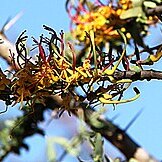Petals connivent or joined in lower part, slightly to markedly curved in bud, mostly red or yellow, with 2 rows of oblique folds below filament insertion, these parts connivent, the upper part narrow below the linear-lanceolate to linear-spathulate tips, reflexing, looped and often twisted; corolla tube, if present, sometimes with further series of flaps or a lobed ledge.
Style inserted in a depression on the ovary, filiform, angular, slightly curved to sinuous, sometimes corrugated near base, only slightly thickened where anthers appressed in bud; stigma capitate.
Flowers (1)few in umbels in the axils or terminal on short shoots, 5-merous; bract saucer-shaped, with a small umbonate or spurred oblong to ovate-triangular limb, sometimes lacerate.
Leaves irregularly opposite to alternate, often clustered on short shoots, sessile to shortly petiolate, leathery to slightly fleshy, palminerved.
Stamens following curve of style and subequal in length, red at least above; anthers 4-thecous.
Stems a few cm to several m, spreading by haustoria-bearing surface runners.
Berry red or yellow, ellipsoid or urceolate, smooth or warty.
Calyx rim-like to cupular, sometimes split as flower opens.
